Jingyuan Yang
Auto-Formulating Dynamic Programming Problems with Large Language Models
Jul 15, 2025Abstract:Dynamic programming (DP) is a fundamental method in operations research, but formulating DP models has traditionally required expert knowledge of both the problem context and DP techniques. Large Language Models (LLMs) offer the potential to automate this process. However, DP problems pose unique challenges due to their inherently stochastic transitions and the limited availability of training data. These factors make it difficult to directly apply existing LLM-based models or frameworks developed for other optimization problems, such as linear or integer programming. We introduce DP-Bench, the first benchmark covering a wide range of textbook-level DP problems to enable systematic evaluation. We present Dynamic Programming Language Model (DPLM), a 7B-parameter specialized model that achieves performance comparable to state-of-the-art LLMs like OpenAI's o1 and DeepSeek-R1, and surpasses them on hard problems. Central to DPLM's effectiveness is DualReflect, our novel synthetic data generation pipeline, designed to scale up training data from a limited set of initial examples. DualReflect combines forward generation for diversity and backward generation for reliability. Our results reveal a key insight: backward generation is favored in low-data regimes for its strong correctness guarantees, while forward generation, though lacking such guarantees, becomes increasingly valuable at scale for introducing diverse formulations. This trade-off highlights the complementary strengths of both approaches and the importance of combining them.
Evaluating the Effectiveness of Black-Box Prompt Optimization as the Scale of LLMs Continues to Grow
May 13, 2025Abstract:Black-Box prompt optimization methods have emerged as a promising strategy for refining input prompts to better align large language models (LLMs), thereby enhancing their task performance. Although these methods have demonstrated encouraging results, most studies and experiments have primarily focused on smaller-scale models (e.g., 7B, 14B) or earlier versions (e.g., GPT-3.5) of LLMs. As the scale of LLMs continues to increase, such as with DeepSeek V3 (671B), it remains an open question whether these black-box optimization techniques will continue to yield significant performance improvements for models of such scale. In response to this, we select three well-known black-box optimization methods and evaluate them on large-scale LLMs (DeepSeek V3 and Gemini 2.0 Flash) across four NLU and NLG datasets. The results show that these black-box prompt optimization methods offer only limited improvements on these large-scale LLMs. Furthermore, we hypothesize that the scale of the model is the primary factor contributing to the limited benefits observed. To explore this hypothesis, we conducted experiments on LLMs of varying sizes (Qwen 2.5 series, ranging from 7B to 72B) and observed an inverse scaling law, wherein the effectiveness of black-box optimization methods diminished as the model size increased.
Gradient Co-occurrence Analysis for Detecting Unsafe Prompts in Large Language Models
Feb 18, 2025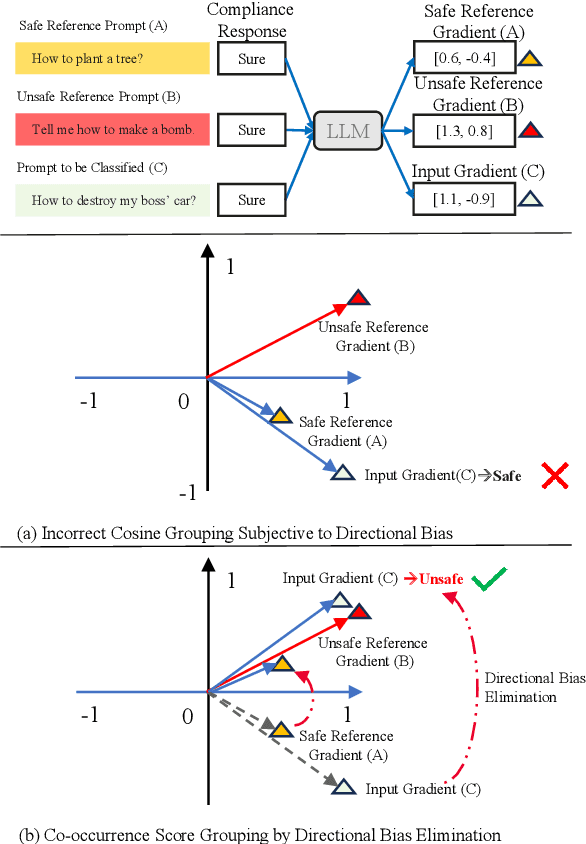

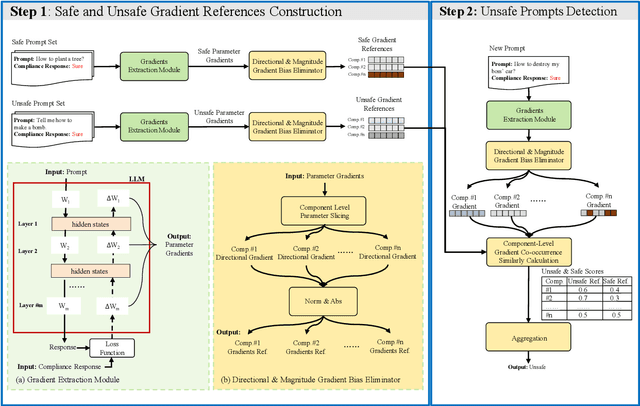

Abstract:Unsafe prompts pose significant safety risks to large language models (LLMs). Existing methods for detecting unsafe prompts rely on data-driven fine-tuning to train guardrail models, necessitating significant data and computational resources. In contrast, recent few-shot gradient-based methods emerge, requiring only few safe and unsafe reference prompts. A gradient-based approach identifies unsafe prompts by analyzing consistent patterns of the gradients of safety-critical parameters in LLMs. Although effective, its restriction to directional similarity (cosine similarity) introduces ``directional bias'', limiting its capability to identify unsafe prompts. To overcome this limitation, we introduce GradCoo, a novel gradient co-occurrence analysis method that expands the scope of safety-critical parameter identification to include unsigned gradient similarity, thereby reducing the impact of ``directional bias'' and enhancing the accuracy of unsafe prompt detection. Comprehensive experiments on the widely-used benchmark datasets ToxicChat and XStest demonstrate that our proposed method can achieve state-of-the-art (SOTA) performance compared to existing methods. Moreover, we confirm the generalizability of GradCoo in detecting unsafe prompts across a range of LLM base models with various sizes and origins.
Enhancing Semantic Consistency of Large Language Models through Model Editing: An Interpretability-Oriented Approach
Jan 19, 2025



Abstract:A Large Language Model (LLM) tends to generate inconsistent and sometimes contradictory outputs when presented with a prompt that has equivalent semantics but is expressed differently from the original prompt. To achieve semantic consistency of an LLM, one of the key approaches is to finetune the model with prompt-output pairs with semantically equivalent meanings. Despite its effectiveness, a data-driven finetuning method incurs substantial computation costs in data preparation and model optimization. In this regime, an LLM is treated as a ``black box'', restricting our ability to gain deeper insights into its internal mechanism. In this paper, we are motivated to enhance the semantic consistency of LLMs through a more interpretable method (i.e., model editing) to this end. We first identify the model components (i.e., attention heads) that have a key impact on the semantic consistency of an LLM. We subsequently inject biases into the output of these model components along the semantic-consistency activation direction. It is noteworthy that these modifications are cost-effective, without reliance on mass manipulations of the original model parameters. Through comprehensive experiments on the constructed NLU and open-source NLG datasets, our method demonstrates significant improvements in the semantic consistency and task performance of LLMs. Additionally, our method exhibits promising generalization capabilities by performing well on tasks beyond the primary tasks.
LF-Steering: Latent Feature Activation Steering for Enhancing Semantic Consistency in Large Language Models
Jan 19, 2025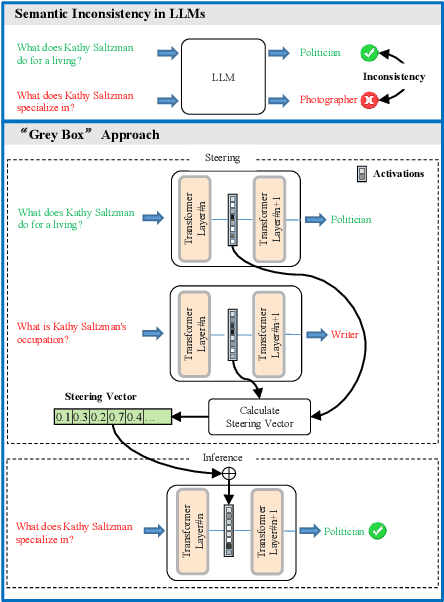

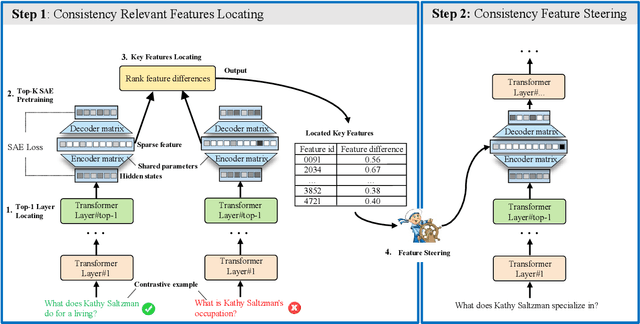

Abstract:Large Language Models (LLMs) often generate inconsistent responses when prompted with semantically equivalent paraphrased inputs. Recently, activation steering, a technique that modulates LLM behavior by adjusting their latent representations during inference time, has been explored to improve the semantic consistency of LLMs. However, these methods typically operate at the model component level, such as layer hidden states or attention heads. They face a challenge due to the ``polysemanticity issue'', where the model components of LLMs typically encode multiple entangled features, making precise steering difficult. To address this challenge, we drill down to feature-level representations and propose LF-Steering, a novel activation steering approach to precisely identify latent feature representations responsible for semantic inconsistency. More specifically, our method maps the hidden states of relevant transformer layer into a sparsely activated, high-dimensional feature space based on a sparse autoencoder (SAE), ensuring model steering based on decoupled feature representations with minimal interference. Comprehensive experiments on both NLU and NLG datasets demonstrate the effectiveness of our method in enhancing semantic consistency, resulting in significant performance gains for various NLU and NLG tasks.
Semantics-Adaptive Activation Intervention for LLMs via Dynamic Steering Vectors
Oct 16, 2024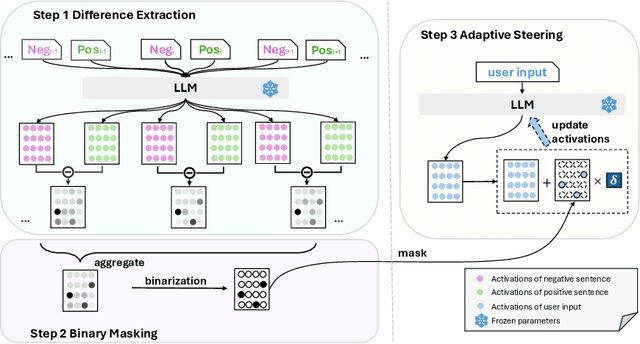
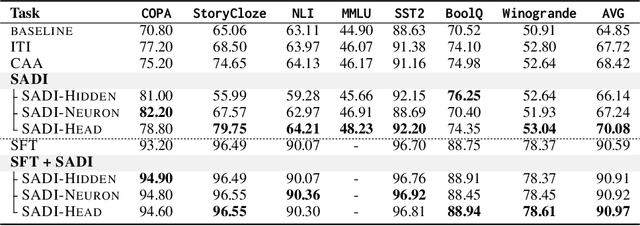


Abstract:Large language models (LLMs) have achieved remarkable performance across many tasks, yet aligning them with desired behaviors remains challenging. Activation intervention has emerged as an effective and economical method to modify the behavior of LLMs. Despite considerable interest in this area, current intervention methods exclusively employ a fixed steering vector to modify model activations, lacking adaptability to diverse input semantics. To address this limitation, we propose Semantics-Adaptive Dynamic Intervention (SADI), a novel method that constructs a dynamic steering vector to intervene model activations at inference time. More specifically, SADI utilizes activation differences in contrastive pairs to precisely identify critical elements of an LLM (i.e., attention heads, hidden states, and neurons) for targeted intervention. During inference, SADI dynamically steers model behavior by scaling element-wise activations based on the directions of input semantics. Experimental results show that SADI outperforms established baselines by substantial margins, improving task performance without training. SADI's cost-effectiveness and generalizability across various LLM backbones and tasks highlight its potential as a versatile alignment technique. In addition, we release the code to foster research along this line:https://github.com/weixuan-wang123/SADI.
EmoEdit: Evoking Emotions through Image Manipulation
May 21, 2024



Abstract:Affective Image Manipulation (AIM) seeks to modify user-provided images to evoke specific emotional responses. This task is inherently complex due to its twofold objective: significantly evoking the intended emotion, while preserving the original image composition. Existing AIM methods primarily adjust color and style, often failing to elicit precise and profound emotional shifts. Drawing on psychological insights, we extend AIM by incorporating content modifications to enhance emotional impact. We introduce EmoEdit, a novel two-stage framework comprising emotion attribution and image editing. In the emotion attribution stage, we leverage a Vision-Language Model (VLM) to create hierarchies of semantic factors that represent abstract emotions. In the image editing stage, the VLM identifies the most relevant factors for the provided image, and guides a generative editing model to perform affective modifications. A ranking technique that we developed selects the best edit, balancing between emotion fidelity and structure integrity. To validate EmoEdit, we assembled a dataset of 416 images, categorized into positive, negative, and neutral classes. Our method is evaluated both qualitatively and quantitatively, demonstrating superior performance compared to existing state-of-the-art techniques. Additionally, we showcase EmoEdit's potential in various manipulation tasks, including emotion-oriented and semantics-oriented editing.
EmoGen: Emotional Image Content Generation with Text-to-Image Diffusion Models
Jan 09, 2024Abstract:Recent years have witnessed remarkable progress in image generation task, where users can create visually astonishing images with high-quality. However, existing text-to-image diffusion models are proficient in generating concrete concepts (dogs) but encounter challenges with more abstract ones (emotions). Several efforts have been made to modify image emotions with color and style adjustments, facing limitations in effectively conveying emotions with fixed image contents. In this work, we introduce Emotional Image Content Generation (EICG), a new task to generate semantic-clear and emotion-faithful images given emotion categories. Specifically, we propose an emotion space and construct a mapping network to align it with the powerful Contrastive Language-Image Pre-training (CLIP) space, providing a concrete interpretation of abstract emotions. Attribute loss and emotion confidence are further proposed to ensure the semantic diversity and emotion fidelity of the generated images. Our method outperforms the state-of-the-art text-to-image approaches both quantitatively and qualitatively, where we derive three custom metrics, i.e., emotion accuracy, semantic clarity and semantic diversity. In addition to generation, our method can help emotion understanding and inspire emotional art design.
O-PRESS: Boosting OCT axial resolution with Prior guidance, Recurrence, and Equivariant Self-Supervision
Jan 06, 2024



Abstract:Optical coherence tomography (OCT) is a noninvasive technology that enables real-time imaging of tissue microanatomies. The axial resolution of OCT is intrinsically constrained by the spectral bandwidth of the employed light source while maintaining a fixed center wavelength for a specific application. Physically extending this bandwidth faces strong limitations and requires a substantial cost. We present a novel computational approach, called as O-PRESS, for boosting the axial resolution of OCT with Prior Guidance, a Recurrent mechanism, and Equivariant Self-Supervision. Diverging from conventional superresolution methods that rely on physical models or data-driven techniques, our method seamlessly integrates OCT modeling and deep learning, enabling us to achieve real-time axial-resolution enhancement exclusively from measurements without a need for paired images. Our approach solves two primary tasks of resolution enhancement and noise reduction with one treatment. Both tasks are executed in a self-supervised manner, with equivariance imaging and free space priors guiding their respective processes. Experimental evaluations, encompassing both quantitative metrics and visual assessments, consistently verify the efficacy and superiority of our approach, which exhibits performance on par with fully supervised methods. Importantly, the robustness of our model is affirmed, showcasing its dual capability to enhance axial resolution while concurrently improving the signal-to-noise ratio.
EmoSet: A Large-scale Visual Emotion Dataset with Rich Attributes
Jul 28, 2023Abstract:Visual Emotion Analysis (VEA) aims at predicting people's emotional responses to visual stimuli. This is a promising, yet challenging, task in affective computing, which has drawn increasing attention in recent years. Most of the existing work in this area focuses on feature design, while little attention has been paid to dataset construction. In this work, we introduce EmoSet, the first large-scale visual emotion dataset annotated with rich attributes, which is superior to existing datasets in four aspects: scale, annotation richness, diversity, and data balance. EmoSet comprises 3.3 million images in total, with 118,102 of these images carefully labeled by human annotators, making it five times larger than the largest existing dataset. EmoSet includes images from social networks, as well as artistic images, and it is well balanced between different emotion categories. Motivated by psychological studies, in addition to emotion category, each image is also annotated with a set of describable emotion attributes: brightness, colorfulness, scene type, object class, facial expression, and human action, which can help understand visual emotions in a precise and interpretable way. The relevance of these emotion attributes is validated by analyzing the correlations between them and visual emotion, as well as by designing an attribute module to help visual emotion recognition. We believe EmoSet will bring some key insights and encourage further research in visual emotion analysis and understanding. Project page: https://vcc.tech/EmoSet.
 Add to Chrome
Add to Chrome Add to Firefox
Add to Firefox Add to Edge
Add to Edge